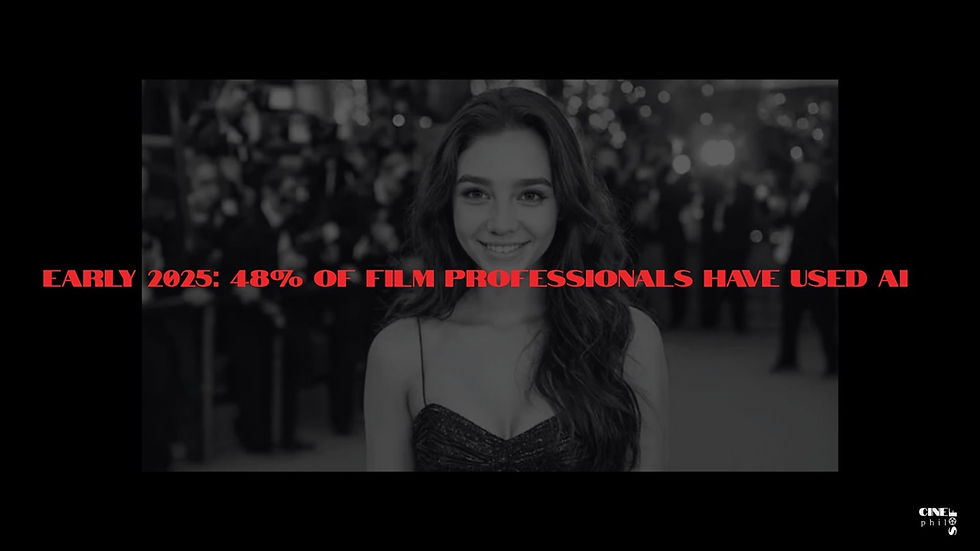Body Horror and Beauty: The 'Beast' Within 'The Substance' - A Feminist Gaze
- Sofia R. Willcox

- Sep 19, 2024
- 4 min read
Updated: Sep 27, 2024
On September 18, 2024, The Substance, directed by Coralie Fargeat, was released, marking Demi Moore's return to the silver screen and generating significant buzz. This gripping film follows a fading celebrity who turns to a black-market drug to create a younger version of herself. With Halloween approaching, it’s the perfect time to explore this feminist take on the body horror subgenre—a grotesque critique of our obsession with youth, presented through a revolutionary female lens. In 2024, a year that has spotlighted MILF protagonists in romantic comedies as both desirable and driven by their own desires, this film provides timely commentary. This analysis will examine how body horror has evolved over the decades and what these unsettling narratives reveal about our society’s anxieties.
Body horror traces its roots to a blend of Gothic literature and early American pre-code horror films. Notably, the Hays Code, which governed American film content from 1930 to 1968 and prohibited grotesque and disturbing imagery, significantly shaped the genre. Despite these restrictions, The Fly (Kurt Neumann, 1958) is often hailed as a pioneering work in body horror. The constraints imposed by the Hays Code help explain why the 1970s and 1980s are frequently regarded as the golden age of body horror, marking the genre’s definitive emergence on the big screen.
Body horror typically focuses on the grotesque distortion and transformation of the human body, often incorporating surrealism, science fiction, or the supernatural. It frequently features striking special effects and serves as a potent vehicle for social commentary.

Body horror emerged as a powerful cinematic response to the social turbulence and revolutionary shifts of the 1970s. Alongside the rise of counterculture movements, the second wave of feminism, the civil rights struggle, and the Stonewall Riots, this genre mirrored the era’s anxieties and transformations. It explored themes of identity, bodily autonomy, and societal fears through grotesque and unsettling depictions of the human form.
While male protagonists are often associated with a loss of authority and masculinity, as well as body control, the female body is viewed as a battleground—oppressed and contested. In mainstream slasher and horror films, women—whether white cisgender or from minority groups—often serve as the primary victims. These portrayals are typically framed through the male gaze, objectifying women as either sources of pleasure for straight male viewers or targets of the director’s own disgust. This often reflects an underlying misogyny toward womanhood, including natural processes like puberty and aging, as well as body choices related to motherhood and perpetuation to unreachable beauty standards. These films frequently focus on mutilation and suffering, featuring gratuitous scenes of women in distress, sexualized violence, the ever-present threat of a male attacker, and use-and-abuse of women in refrigerator.
Over the decades, body horror has evolved to reflect changing societal concerns and technological advancements. What began with fears of scientific experimentation and infection has expanded into modern critiques of gender, identity, and technology, especially if there is a female hands behind these productions. However, some contemporary body horror films can be seen as transphobic or ableist, as their grotesque transformations often signify 'otherness' and reinforce harmful stereotypes. Additionally, the genre can marginalize minority groups further, reinforcing white, cisgender, and heteronormative perspectives while making other identities invisible.

However, a feminist lens shows that body horror can be both demeaning and empowering. The genre offers a critical perspective on the portrayal of female bodies and their pain, challenging and recontextualizing these depictions for a more nuanced commentary. At times, it subverts expectations, using body horror to explore female experiences, psychological landscapes, and sometimes the sexualization of trauma. The concept of the "monstrous feminine," introduced by Barbara Creed in her 1993 book, redefines women’s roles in horror. Rather than being mere victims, women become sources of fear, embodying societal anxieties about female sexuality, reproduction, and bodily autonomy. This subversion of patriarchal norms presents the female body as both monstrous and powerful, reflecting deeper fears about gender and the disruption of traditional roles. By exploring body horror and its evolution, The Substance provides a contemporary feminist critique that aligns with the genre's historical roots and societal reflections.
The Substance resonates with Demi Moore’s career journey. Known for her early work in the 1980s, including films like Choices (Silvio Narizzano, 1981) and the soap opera General Hospital, Demi Moore gained prominence with Ghost (Jerry Zucker, 1990). Despite publicly denying major cosmetic surgeries and attributing her appearance to healthy living and self-care, speculation about her cosmetic journey persists.
In the 1990s, Moore was a Hollywood icon, embodying beauty standards and complex characters that were tough yet vulnerable, sexual yet in control. Her role in G.I. Jane (1997) was particularly notable for its depiction of female empowerment, with the head-shaving scene serving as a bold and powerful statement. Although her screen presence has waned in recent years, Moore remains a pioneer in advocating for equal pay for women in Hollywood.
The Substance mirrors these themes, offering a contemporary critique of aging and celebrity through a feminist lens. Amid the rise of feminist debates on ageism and cosmetic surgeries, the film reflects these issues with a sharp focus.




Comments